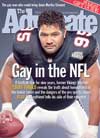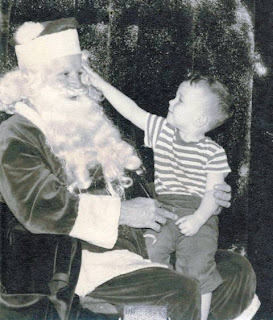PHOTO: (above) George Hastings (top row, left) and the 1910 football team at Oregon Agricultural College (former name of Oregon State University) as pictured in "The 1912 Orange" yearbook, p. 159. See previous posts OSU gay football player 1908 (6/19/08) and Oregonian on 1912 gay panic arrests (4/25/10)
 PHOTO: former Oregon State University football player Esera Tuaolo came out on the cover of The Advocate. ("Tackling football's closet," By Bruce C. Steele, The Advocate, Nov. 26, 2002, cover story, pp. 3, 30-39). See previous posts OSU Esera Tuaolo gay football star (8/12/06) and OSU alum on CBS 'Face the Nation,' Jason Collins comes out, and Boy Scouts in local paper (5/7/13).
PHOTO: former Oregon State University football player Esera Tuaolo came out on the cover of The Advocate. ("Tackling football's closet," By Bruce C. Steele, The Advocate, Nov. 26, 2002, cover story, pp. 3, 30-39). See previous posts OSU Esera Tuaolo gay football star (8/12/06) and OSU alum on CBS 'Face the Nation,' Jason Collins comes out, and Boy Scouts in local paper (5/7/13).
Research done by George Painter of the Gay and Lesbian Archives of the Pacific Northwest, which connected an Oregon State University football player in the 1910 and 1912 football seasons to men arrested in the 1912 Portland Vice Clique scandal, was referenced in the history by Thomas Kraemer, "Corvallis, Oregon State University gay activism 1969-2004," printed to PDF from OutHistory.org in 2010 that is permanently stored by the OSU Scholars Archives@OSU. (Note: I originally wrote it for the Corvallis, Oregon State University outhistory.org exhibit and donated it for public access to the OutHistory.org site founded by gay historian Jonathan Ned Katz at the City University of New York CLAGS, which is now hosted by John D'Emilio of the University of Illinois Chicago. My OSU gay history is also linked to from the Oregon State University Pride Center history page. (See previous post OSU gay history at OutHistory.org site (1/16/12))
I am looking forward to reading the new book by George Painter, "The Vice Clique," 296 pages, self-published via On Demand Books available through Espresso Book Machine.
(As an aside, this will be my first customer experience with this particular on-demand publishing system, which I dreamed about having access to decades ago before it was technically possible. A printed copy of the book is scheduled to come in the mail to me in a few days, but it may take me some time to find a friendly grad student to read it to me because there is no accessible digital copy available for sale.)
A short review of George Painter's new book was printed in a Portland, Oregon gay newspaper. Selected quotes from Robin Will's book review that caught my attention are listed below:
". . . In November of 1912, The Portland News was selling extra editions on the street, with stories of queer sex and suicide at the YMCA. . .
Historian George Painter documents the events and their repercussions in his book, The Vice Clique: Portland's Great Sex Scandal, self-published in December 2013, available through Espresso Book Machine. . .
The News' coverage was barely factual, as George Painter discovered when he started digging through police records, trial transcripts, and accounts from competing newspapers. . .
Painter also examines the legal legacies of this uproar, which included a law that allowed for neutering of undesirables in Oregon until its repeal in 1983. . .
Historians will be using this book for reference; but Painter's prose style is accessible, and the book could conceivably be read for background or entertainment. . .
. . .in the mindset of 1912, apparently there was no such thing as consensual gay sex: there were only perpetrators and "boy victims." A boy victim in one crime could become a perpetrator elsewhere, if his subsequent "victim" was younger. . .
As a direct result of the Vice Clique scandal, the definition of sodomy was ludicrously broadened, and the maximum penalty tripled-from 5 to 15 years. That law stood until 1971. . . ."
(Quoted from Robin Will, "Vice Clique: An Old-Fashioned Gay Sex Scandal," (Portland, Oregon) PQ Monthly pqmonthly.com posted Mar. 19, 2014. Or see "George Painter's Vice Clique book is available now!" glapn.org accessed Mar. 21, 3014 for another copy of this book review)
The anti-gay laws in the early part of the 20th Century were fueled, in part, by the well-meaning attempt to improve "social hygiene" as a means of stopping the spread of sexually transmitted diseases in addition to improving the moral standards of men and women.
Ironically, it appears to me, given my reading of history, that it was a gender queer woman, employed as a police officer in Portland, Oregon, who was a key leader of the anti-sex social hygiene movement in Oregon to protect women from men's bad sexual behavior. She was also a women's suffragist who fought for the rights of women to vote in Oregon. (Note: See various definitions of suffrage) This possible connection between anti-gay laws and women suffragists occurred to me after watching two very interesting documentaries:
- "Lola G. Baldwin," Oregon Experience on Oregon Public Broadcasting Broadcast Date: May 15, 2008 -- On April 1, 1908 Lola G. Baldwin was sworn in "to perform police service" for Portland, Oregon and became the nation's first policewoman. As Superintendent of the new Women's Protective Division, Detective Baldwin crusaded for the moral and physical welfare of young, single working women.
- "The Suffragists," Oregon Experience on Oregon Public Broadcasting Broadcast Date: November 05, 2012 -- Until 1912, Oregon women lived by men's law. They had few legal rights with little power to improve their lives or communities. That changed when women won the right to vote.
In a future post, I hope to share my notes on what I learned from reading George Painter's new book. In addition, I hope to better understand the Portland Vice Clique scandal's linkage to the 1912 Women's Suffrage movement and how this later influenced homophile activists in the 1950's, as well as 1960's Stonewall era gay liberationists and the contemporaneous Women's Liberation movement.
My current hypothesis is that the biological "disgust reaction" that many homophobic heterosexual humans exhibit in Functional MRI machines when thinking about gay sex, along with the historical discrimination against women by heterosexual men, is at the root of both secular and biblical laws against sexual activities, including laws prohibiting homosexual behavior, which have historically been used to legally sanction discrimination against gay men and women by citing public health concerns and or Darwinian evolutionary survival of the fittest theories.
Speaking of disgust reactions, I had a disgust reaction to the following story about heterosexuals having public sex, which ironically is what gay men are often accused of doing by those who want to discriminate against both gay men and women. The social construction theory behind gay men and public sex is very rich and it is often referenced in gay porn and scholarly essays and books written on the subject of gay tearooms, such as in the recent case of a U.S. Senator Larry Craig from Idaho who was arrested for tearoom homosexual behavior. (Note: my local, mainstream newspaper regularly prints nearly all of the local police reports because they have found it to be popular with readers and it costs them virtually nothing to fill the space):
This log includes incidents in which there might have been a public disturbance or a risk to the public. Information comes from the Corvallis Police Department and the Benton County Sheriff's Office.
Corvallis Police Department
THURSDAY, MARCH 20
PUBLIC INDECENCY: 2:42 p.m., Northwest Highland Drive and Spruce Avenue. Police arrested 47-year-old Mary Mazely and 51-year-old Paul Antonio Martin -- neither with listed addresses -- on a charge of public indecency after a nearby resident reported that a woman was performing oral sex on a man at the bus shelter. Martin also had a Polk County warrant for his arrest for a parole violation.
(Quoted from "Police Log (March 22)," Gazette-Times (Corvallis, Oregon) gazettetimes.com posted Mar. 22, 2014)
Of course, it is amusing that this was printed in what the paper's own editor recently described as a "family newspaper" and it is the same newspaper that in the 1970's printed numerous letters to the editor by angry readers threatening to cancel their subscriptions to what they called a "family newspaper" after the newspaper had printed an article profiling two lesbian women who loved each other so much they wanted to get married. (See previous post Gay 1976 newspaper controversy (5/3/06) on gay women in Corvallis wanting to get married)




